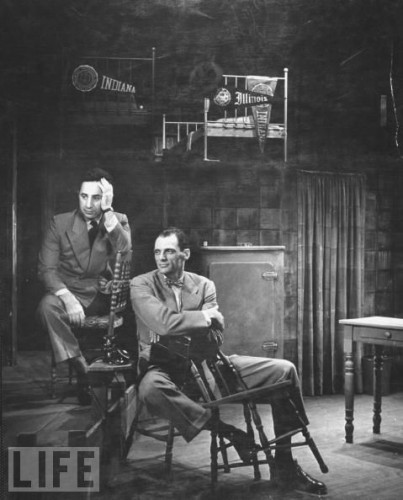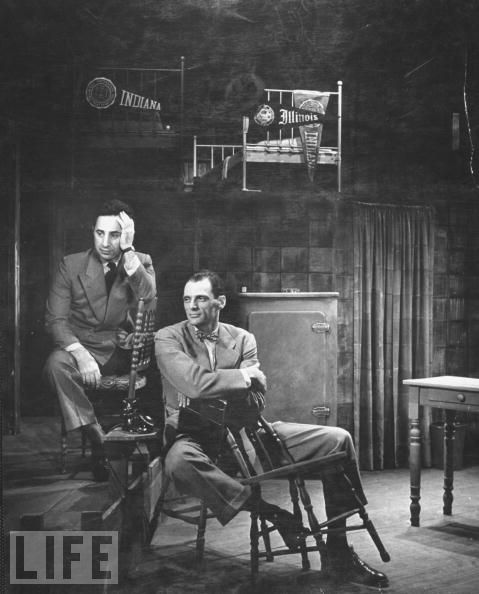Tomorrow, the nominees for this year’s Tony Awards will be announced. Once again, there will be no category for Prop Design, or recognition of props people in any capacity. The only time a props person has ever been recognized at the Tony’s was in 1949, when Joe Lynn won for his work as master propertyman on Miss Liberty in the (now defunct) category of “Best Stage Technician”. I first wrote about him in my article asking “Why is there no Tony Award for Props?” and I thought I would write a little more about what I know of him (especially now that I’ve added a “Joe Lynn” page on Wikipedia).
He was born in August of 1887 and died in 1969. His career in props began in 1915, and by his own account, he has worked on hundreds of Broadway shows.
Ethan Frome
In 1936, a dramatic version of the novel Ethan Frome was put on at the National Theatre. It was staged by Guthrie McClintic, with scenic design by Jo Mielziner. The stage was covered in snow, and I wrote about Joe Lynn’s solution to the snow in a previous post:
After much trial and error, they arrived at a mixture of white cornmeal, ground quartz and powdered mica flakes.
The Eve of St. Mark
Joe Lynn was the prop master of the 1942 production of The Eve of St. Mark at the Cort Theatre. It was directed by Lem Ward, with scenic design by Howard Bay. The May 22, 1943, issue of The New Yorker featured a short article on the letters which Lynn created for this production.
Every day, and twice a day on matinée days, he has written a real letter for the use of Mary Rolfe, who plays the girl, and she has added a few words of her own before sealing it. There’s no need for any of this super-realism, you understand; a sheet of paper with a few random scribbles on it would be good enough to fool even the people in the front row.
The show ran for 307 performances, and Joe wrote a letter for each one; when the show went on tour, the prop man for the road company was ordered to follow in this tradition. The July 5, 1943, issue of The Princeton Bulletin reveals that Lynn had donated three of these letters for their exhibit on Maxwell Anderson, the author of The Eve of St. Mark. You can read the issue online or download a PDF of it.
Death of a Salesman
1949 saw Lynn again working with Jo Mielziner as well as director Elia Kazan for the Broadway premiere of Death of a Salesman at the Morosco Theatre. In his 1965 memoir, Mielziner writes about the difficulty in finding a particular icebox for the show:
[T]hey were hard to find, even in the best junkyards. However, [Lynn] told me not to worry: “We’ll allow ourselves enough time so that if we can’t find one, we can make it.” A good property man like Joe Lynn is incredibly versatile; what he can’t find, he must–and can–make.
You can see the icebox–and other props which Lynn built and acquired–in the photograph below:

Miss Liberty
Joe Lynn was the props master on the 1949 production of Miss Liberty at the Imperial Theatre. This show was directed by Moss Hart, choreographed by Jerome Robbins, and the sets and costumes were designed by Oliver Smith. The show itself was not very well received, and the Tony Award which Lynn received for the show was the only nod the show got at the awards; it was the same year South Pacific had come out, which snatched up ten Tony’s.
The Tony Award for Best Stage Technician was received by only 14 people, and ceased to be a category after 1963. Joe Lynn was the only property master to win one.
Cat on a Hot Tin Roof
Joe Lynn worked again with Kazan and Mielziner on the 1955 debut of Cat on a Hot Tin Roof at the Morosco. Besides its importance in the history of American theatre, the show is also noteworthy for being Ming Cho Lee’s first paid Broadway gig. In Designing and Painting for the Theatre, by Lynn Pecktal, Lee himself tells us:
Then I did a bar in Cat on a Hot Tin Roof that was very important. A portion of the bar lifted up and it was all catty-cornered on a raked platform. Joe Lynn, the prop man on that show, said we would have to build it because we would never find it. And I drew the bar so accurately that he was able to build it straight from the drawing and it worked, which was a marvelous compliment.
Lee is being a little modest here. In USITT presents the designs of Ming Cho Lee, Delbert Unruh tells us:
Warren Clymer had left the studio and Lee was assisting on all of the shows, but it was his drafting of the complicated bar unit for Cat on a Hot Tin Roof that got him his first paycheck. The bar had to open up at the flip of a switch and it was sitting on a raked stage. Lee prepared the drafting of the bar and it was sent to Joe Lynn, the legendary Broadway prop man. Lynn came to the studio to discuss the props for Cat on a Hot Tin Roof and told Mielziener, “This kid is OK. I can build from this drawing.” He became the second assistant in the studio at $75.00 per week and now felt fully vindicated in the eyes of his father and stepfather.
So in his own small way, Joe Lynn had a part in Ming Cho Lee’s success, a path which would lead to Lee becoming one of the father’s of contemporary American scene design.
Other Broadway productions
Nobody thinks to include props people and other stage technicians in their databases, so searching for other shows which Joe Lynn has worked on involves going through the original Playbills from the time period. A few I’ve found include:
| 1943 | A New Life | Royale Theatre | written and directed by Elmer Rice | Scenic Design by Howard Bay |
| 1960 | Send Me No Flowers | Brooks Atkinson Theatre | directed by James Dyas | Scenic Design by Frederick Fox |
| 1961 | Under the Yum-Yum Tree | Henry Miller’s Theatre | directed by Joseph Anthony | Scenic Design by Oliver Smith |
| 1963 | The Private Ear and The Public Eye | Morosco Theatre | directed by Peter Wood | Production Design by Richard Negri |
For Send Me No Flowers, the credit is listed as “special props by Joe Lynn and Dunkel Studio Associates”. Anyone who has access to other Playbills of the time and can search for shows Joe has worked, I’d love to hear about it. For that matter, anyone who has further information or anecdotes about the only Tony Award—winning props master, drop me a line.
Update (July 31, 2014):
The article originally stated Lynn was born on February 2, 1898, and died March 15, 1984, which was totally wrong. I’ve updated the post with the correct information.





